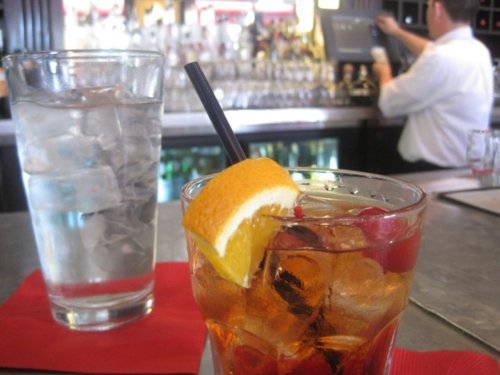
In the early stages of my ongoing evolutionary stumble toward cocktail geekdom, the Negroni was probably fourth or fifth. One at a time, I discovered certain drinks and clung onto them like handholds amid the fray as I felt my way around this dizzying new world beyond beer and simple mixed drinks — the Martini, the Vesper, the Aviation.
Somewhere along the way I found the Negroni, a classic cocktail that remains entrenched in the pantheon of drinks I return to again and again at home and beyond, solid as an Iron Chef under the spotlight.
Campari is its heart — yes, Campari, the brilliant red Italian aperitif with the distinctively bitter character. For some, the familiar bottle conjures images of grandpa’s liquor shelf — the Negroni dates back to at least the 1950s — but I’m already sensitive enough about the white hairs starting to muscle their way into the thicket atop my head. You don’t need to compare me to Christopher Plummer.
This kinda sorta happened the other night when I popped into my local watering hole and considered the bartender’s offer to spice up my basic gin and tonic with a splash of Campari.
“Campari?” a woman nearby said. “Isn’t that an old man’s drink?”
I was aghast. You should be too. Call it bitter — hell, call me bitter — but don’t call it that.
The apertif’s forceful flavor is not for everyone, but it’s not mean like Grappa. It starts out smooth but develops into something far more edgy, the stylish guy who shows up at a party and destroys everyone at the pool table before disappearing into the night. Who was that guy? everyone asks. That was Campari.
You can top it with club soda, or you can mix it with wine or orange juice. Balanced with sweet vermouth and held at bay by club soda, it becomes an Americano.
For me, though, it’s the Negroni that captures Campari’s best qualities.
Consummate mixologist Gary Regan calls the Negroni one of the world’s finest drinks. While legend has it that around 1919, a certain Count Negroni asked an Italian bartender to make an Americano using gin for club soda, the earliest recipes Regan could find for it surface around 1955.
Equal parts Campari, gin and sweet vermouth, garnished with an orange twist, it’s one of the simplest drinks to make — and yet one of the easiest to spoil, a delicate dance of bitter and sweet that can easily come off as too much of one or the other.
“The balance is of primary importance in a Negroni,” Regan writes in The Joy of Mixology. “Using equal part of each ingredient is absolutely necessary to achieve perfection.”
It’s one of the drinks I’ll order when trying out a new bar — or specifically, a new bartender. While variations exist — Dallas’ Private/Social makes a luscious one with a fantastically delicious, prime-quality vermouth — I believe Campari is its essence.
As my friend Ryan, a fellow cocktail enthusiast, pointed out the other day, Liquor.com carried a recipe for something called an “East Indian Negroni.” It subbed rum for gin, sherry for vermouth and Luxardo bitter liqueur for Campari. Is that still a Negroni? More like a Ne-phony, if you ask me.
J.W. Tate, the guy behind the craft cocktail program at Tate’s in Dallas, calls the Negroni “the essence of life.” “It’s not obnoxiously strong,” he says. “There’s a lot of layers there. It’s the best drink there is.”
2 thoughts on “Muh-muh-muh-my…. Negroni”
Comments are closed.